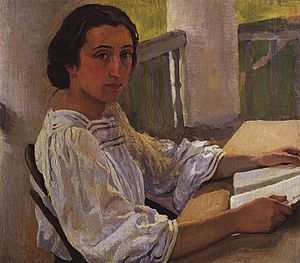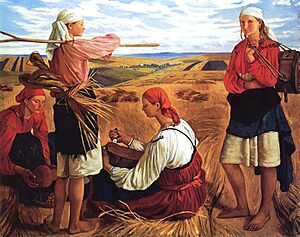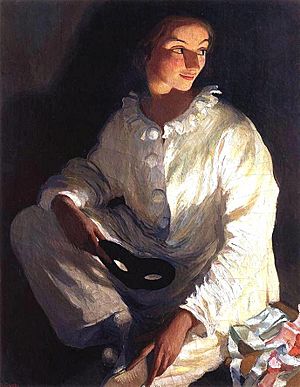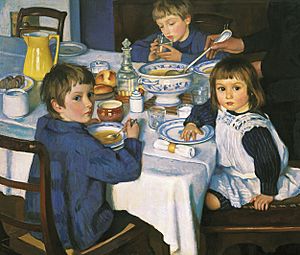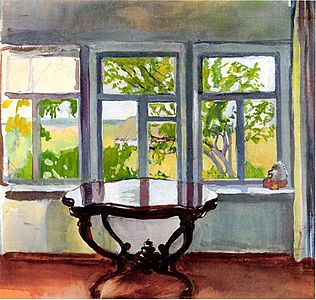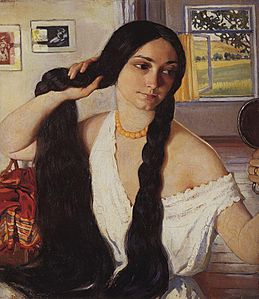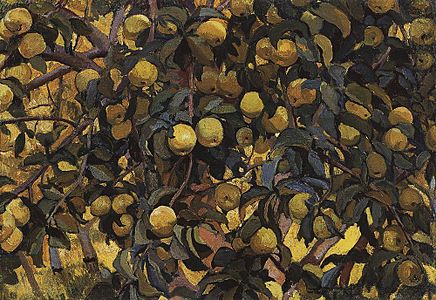Zinaida Serebriakova facts for kids
Quick facts for kids
Zinaida Serebryakova
|
|
|---|---|
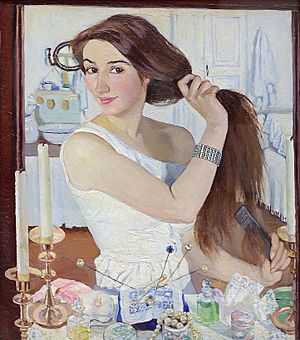
At the Dressing-Table. Self-Portrait (1909)
|
|
| Born |
Zinaida Yevgenyevna Lancere
10 December [O.S. 30 November] 1884 |
| Died | 19 September 1967 (aged 82) |
| Nationality | Russian, French |
| Education | by Osip Braz, Repin, Académie de la Grande Chaumière |
| Known for | Painting |
| Movement | Representational, Neoclassical Revival, Mir iskusstva |
| Spouse(s) |
Boris Serebryakov
(m. 1905; died 1919) |
Zinaida Serebryakova was a famous painter from Russia. She was born on December 12, 1884, and passed away on September 20, 1967. Later in her life, she also became a French citizen. She is known for her beautiful portraits and scenes of everyday life.
Contents
Her Artistic Family
Zinaida Serebryakova was born in a place called Neskuchnoye, near Kharkiv, Ukraine. Her family, the Benois, were very artistic. Her father, Evgenii Lansere, was a sculptor. Her mother, Ekaterina Lansere, was a painter.
Her grandfather, Nicholas Benois, was a well-known architect. Her uncle, Alexandre Benois, was also a painter. He helped start an art group called Mir iskusstva, which means "World of Art." Zinaida's brothers were also artists. Nikolay Lanceray was an architect. Yevgeny Yevgenyevich Lanceray was a master of large paintings and graphic art. The famous English actor Peter Ustinov was also related to her.
Her Early Life and Training
In 1900, Zinaida finished high school. She then went to an art school started by Princess Maria Tenisheva. She studied with famous artists like Ilya Repin in 1901. She also learned from Osip Braz, a portrait artist, from 1903 to 1905.
She traveled to Italy in 1902 and 1903 to learn more about art. From 1905 to 1906, she studied at a special art school in Paris, France, called the Académie de la Grande Chaumière. In 1905, she married her cousin, Boris Serebryakov. He later became a railroad engineer, and she took his last name.
Becoming a Famous Artist
One of Serebryakova's most famous paintings is her self-portrait, At the Dressing-Table (1909). She painted it when she was stuck at home because of heavy snow. Her brother, Evgenii, told her to show it at an art exhibition in 1910. People loved it, and it was bought for the Tretyakov Gallery, a famous art museum.
After this, she painted other well-known works. These include Girl Bathing (1911) and portraits of her mother and sister. In 1911, she officially joined the Mir iskusstva art movement. From 1914 to 1917, she painted many pictures about life in the Russian countryside. These include Peasants and Sleeping Peasant Girl.
In 1916, she helped decorate the Kazan Railway Station in Moscow. She painted scenes about the Orient, showing countries like India, Japan, Turkey, and Thailand. She also started paintings about old myths, but she never finished them.
Life During the Revolution
After the Russian Revolution began in 1917, Zinaida's life changed a lot. In 1919, her husband Boris died from a disease called typhus. She was left with no money and had to care for her four children and her sick mother. Their family home was robbed, and they struggled with hunger.
She could no longer afford oil paints. So, she started using charcoal and pencil, which were cheaper. During this hard time, she painted House of Cards. It shows her four children after their father passed away.
Zinaida did not want to paint in the new art styles of the time, like Suprematism. She also did not want to paint portraits of political leaders. She found work at the Kharkov Archaeological Museum. There, she drew pictures of the items on display. In 1920, she moved to her grandfather’s apartment in Petrograd. She was lucky to share the apartment with artists from the Moscow Art Theatre. Because of this, many of her works from this time show scenes from the theater. Her daughter, Tatiana, also started ballet school. Zinaida then created many pastel drawings of the Mariinsky Theatre.
Moving to Paris
In 1924, Zinaida went to Paris, France, for a painting job. She planned to return to the Soviet Union after finishing. Her mother and two of her children, Evgenyi and Tatiana, stayed there. However, she could not go back. She was able to bring her other two children, Alexandre and Catherine, to Paris in 1926 and 1928. But she did not see Evgenyi and Tatiana again for many years.
After this, Serebryakova traveled a lot. In 1928 and 1930, she visited Morocco in Africa. During a six-week trip to Morocco in 1928, she drew over 130 portraits and city scenes. She was fascinated by the landscapes of northern Africa. She painted the Atlas Mountains, Arab women, and Africans in their traditional clothes. She also painted a series about fishermen in Brittany, France. Her later paintings show her deep love for beauty in nature and people.
In 1947, Serebryakova became a French citizen. It was not until 1960 that the Soviet government allowed her to contact her family in Russia. After 36 years, her older daughter, Tatiana, finally visited her. Tatiana was also an artist, painting scenery for the Moscow Art Theatre.
In 1966, Serebryakova's paintings were shown in the Soviet Union for the first time in many years. The exhibitions in Moscow, Leningrad, and Kiev were very popular. Millions of her art books were sold. People compared her to famous artists like Sandro Botticelli and Pierre-Auguste Renoir. Zinaida was very happy about her success in her home country. She sent about 200 of her works to be shown there. However, most of her art remains in France today.
Zinaida Serebryakova passed away in Paris on September 19, 1967, at the age of 82. She is buried in the Russian cemetery at Sainte-Geneviève-des-Bois.
Tribute
On December 10, 2020, Google honored her 136th birthday with a special Google Doodle on their homepage.
Selected Artwork
See also
 In Spanish: Zinaída Serebriakova para niños
In Spanish: Zinaída Serebriakova para niños
- List of Orientalist artists
- Orientalism


